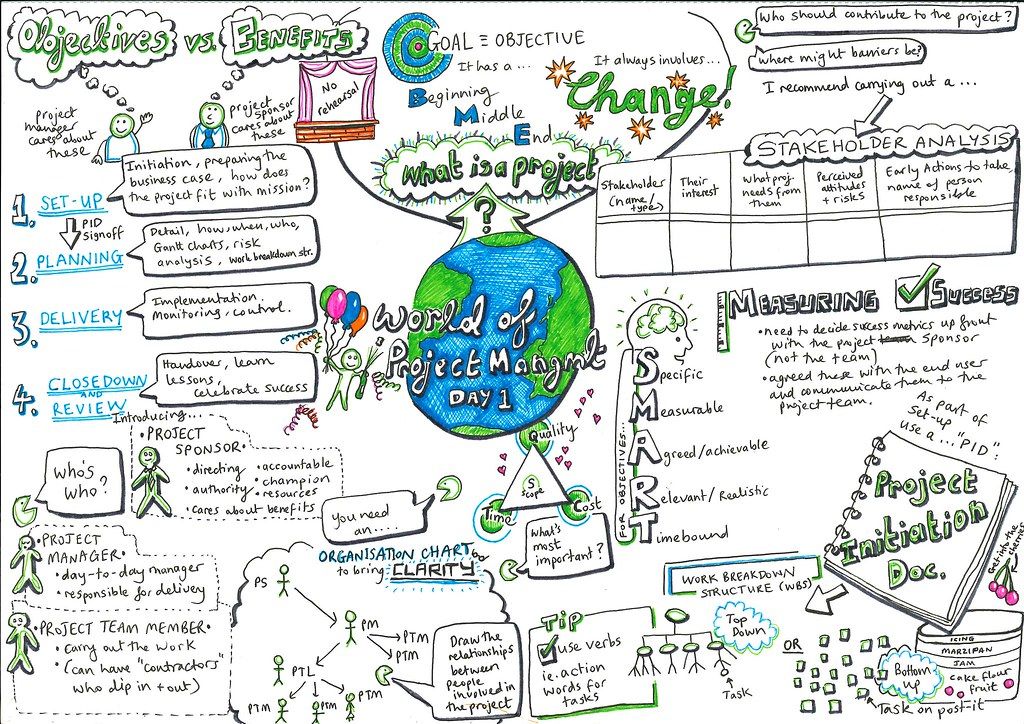IT project management involves strategizing, structuring, and overseeing tech-related initiatives to guarantee they are finished punctually, within financial limits, and aligned with the required quality benchmarks. It also ensures that all stakeholders understand the project’s objectives, duties, and schedules, thus avoiding misunderstandings and delays.
Benefits of IT project management
Clear Goals and Objectives: IT project management assists in outlining specific goals and objectives, guaranteeing that all team members know what must be accomplished. Setting clear objectives simplifies evaluating success.
Efficient Resource Management: Guarantee resources (time, funds, personnel) are utilized effectively, prevent waste, and enhance productivity. Organized systems ensure that assignments are finalized punctually and within financial limits. Project teams can operate more efficiently and minimize needless resource depletion by adhering to organized systems and employing tools. Project managers proficiently distribute resources such as time, finances, and staff, ensuring nothing is squandered. IT project management aids organizations in distributing resources effectively, providing the appropriate individuals and tools that are available at the right moment. Ensures ideal utilization of resources (time, funds, personnel).
Risk Management: Recognize potential threats in advance, enabling proactive prevention. Spotting potential threats early and strategizing how to address them helps avoid complications that could hinder the project. It assists in pinpointing and alleviating possible challenges before they escalate into significant problems, thereby lowering the likelihood of project failure. Efficient project oversight aids in discovering and managing potential threats, averting expensive errors and setbacks.
Improved Communication: Promote improved communication between team members, stakeholders, and clients, ensuring everyone understands the situation. It offers data-driven insights to improve decision-making while project management supports informed choices throughout the project lifecycle.
Quality Control: Helps guarantee the final product fulfills the necessary standards and addresses the client’s requirements. An effective IT project manager ensures that the final output aligns with quality criteria and user demands. Contributes to upholding the quality of outputs through consistent oversight
Timely Delivery: Aids in organizing and timing tasks to guarantee the project’s successful completion. Successfully delivering projects as anticipated keeps stakeholders (those invested in the initiative) content, fostering trust. Customer and end-user satisfaction will likely increase when projects are completed punctually, and expectations are fulfilled.
Stages of IT Project Management
Initiation: This is the strategizing stage for clarifying the project’s aims, boundaries, and viability. Essential stakeholders are recognized, and a project charter is generated to detail the project’s goals and outcomes.
- Idea Generation: Identifying the need for a project.
- Feasibility Study: This assesses whether the project is viable and worth pursuing. A detailed analysis is conducted to determine this.
- Project Charter: Documenting the project’s objectives, scope, and stakeholders. This document defines the project’s goals, objectives, and scope.
- Stakeholder Identification: Key stakeholders and their expectations are identified and gathered.
- Planning: Detailed project plans, including schedules, budgets, risk assessments, and resource allocations, are developed during this phase. This phase maps out how the project will be executed.
- Defining Scope: Clearly outline project deliverables. The project is broken down into smaller, manageable tasks.
- Resource Planning: Involves determining what resources are needed. The necessary resources (people, equipment, materials) are assigned for each task. Tasks are allotted and discussed with team members according to the plan.
- Budgeting: Estimating the costs involved. A project budget is developed to estimate the costs involved.
- Scheduling: Create a project timeline. Outline the sequence of tasks and their estimated duration in a project schedule.
- Risk Management Plan: Identifying potential risks and how to handle them.
- Communication Plan: Establish communication plans to keep everyone informed.
Execution: In this phase, the project plan is implemented. The project manager coordinates tasks, monitors progress, and ensures the team stays on track. Communication with stakeholders is essential here.
- Quality Assurance: Ensuring the work meets the required standards. Quality assurance measures are implemented to ensure that work meets standards.
- Task Execution: The project team performs the planned tasks according to the schedule.
- Monitoring Progress: Keeping track of the project’s progress. Monitor progress through regular meetings and updates.
- Risk Management: Risks are monitored and addressed as they arise.
- Communication: Regular communication is maintained with stakeholders to keep them informed about project progress.
- Monitoring and Controlling: This stage runs concurrently with execution. The project manager tracks progress, adjusts plans as needed, manages risks, and ensures the project stays within scope, time, and budget constraints.
- Progress Tracking: Project progress is monitored and measured against the plan using Key Performance Indicators (KPI).
- Issue Resolution: Identify and resolve any developing issues or problems. Adjust plans as necessary to keep the project on track.
- Change Management: Involves handling any changes to the project scope or plan and managing changes in scope or requirements as they arise.
Closure: Once the project is completed, it is formally closed by handing over deliverables, ensuring all contractual obligations are met, and conducting a post-project evaluation to learn from successes and challenges.
- Final Review: Conduct a final review to ensure all project objectives are met.
- Final Deliverables: Complete any remaining documentation and hand over deliverables. The final product or service is delivered to the customer.
- Project Review: Hold a post-project evaluation meeting to discuss successes and areas for improvement. Evaluate the project’s success or failure and capture insights and best practices for future projects.
- Documentation: Recording all the project details for future reference.
By adhering to these phases, IT project management enhances the chances of projects being completed effectively, providing value and reducing risks and inefficiencies. This organized method helps guarantee that even intricate IT projects can be handled efficiently, benefiting the organization and its stakeholders and boosting the probability of favorable IT project results.

